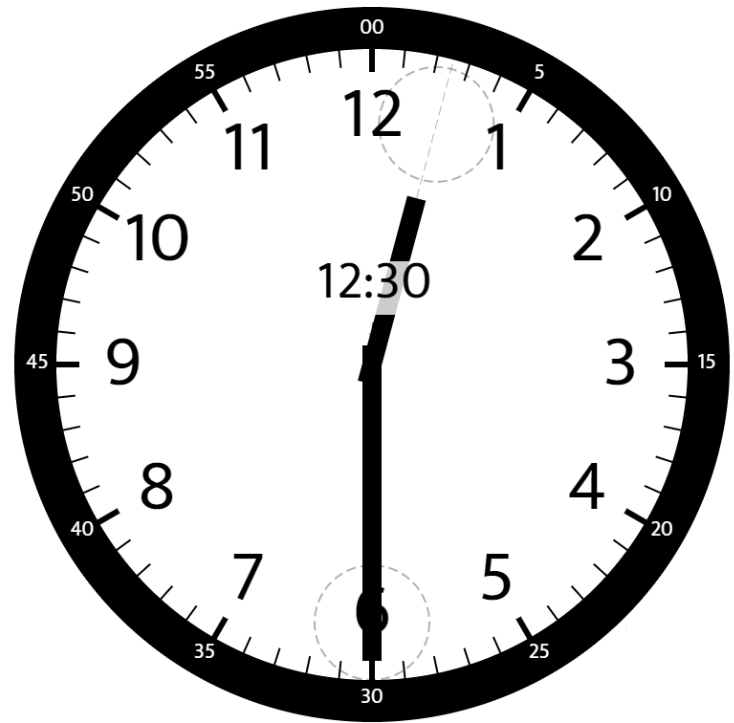https://leetcode.com/problems/angle-between-hands-of-a-clock/
Given two numbers, hour and minutes. Return the smaller angle (in degrees) formed between the hour and the minute hand.
Example 1:

Input: hour = 12, minutes = 30 Output: 165
呀,天亮了
5 年前
https://leetcode.com/problems/angle-between-hands-of-a-clock/
Given two numbers, hour and minutes. Return the smaller angle (in degrees) formed between the hour and the minute hand.
Example 1:

Input: hour = 12, minutes = 30 Output: 165
5 年前
https://leetcode.com/problems/third-maximum-number/
Given a non-empty array of integers, return the third maximum number in this array. If it does not exist, return the maximum number. The time complexity must be in O(n).
Example 1:
Input: [3, 2, 1] Output: 1 Explanation: The third maximum is 1.
5 年前
https://leetcode.com/problems/height-checker/
Students are asked to stand in non-decreasing order of heights for an annual photo.
Return the minimum number of students that must move in order for all students to be standing in non-decreasing order of height.
Notice that when a group of students is selected they can reorder in any possible way between themselves and the non selected students remain on their seats.
Example 1:
Input: heights = [1,1,4,2,1,3] Output: 3 Explanation: Current array : [1,1,4,2,1,3] Target array : [1,1,1,2,3,4] On index 2 (0-based) we have 4 vs 1 so we have to move this student. On index 4 (0-based) we have 1 vs 3 so we have to move this student. On index 5 (0-based) we have 3 vs 4 so we have to move this student.
5 年前
https://leetcode.com/problems/sort-array-by-parity/
Given an array A of non-negative integers, return an array consisting of all the even elements of A, followed by all the odd elements of A.
You may return any answer array that satisfies this condition.
Example 1:
Input: [3,1,2,4] Output: [2,4,3,1] The outputs [4,2,3,1], [2,4,1,3], and [4,2,1,3] would also be accepted.
5 年前
https://leetcode.com/problems/duplicate-zeros/
Given a fixed length array arr of integers, duplicate each occurrence of zero, shifting the remaining elements to the right.
Note that elements beyond the length of the original array are not written.
Do the above modifications to the input array in place, do not return anything from your function.
Example 1:
Input: [1,0,2,3,0,4,5,0] Output: null Explanation: After calling your function, the input array is modified to: [1,0,0,2,3,0,0,4]
5 年前
Given a sorted array of integers nums and integer values a, b and c. Apply a quadratic function of the form f(x) = ax2 + bx + c to each element x in the array.
The returned array must be in sorted order.
Expected time complexity: O(n)
Example 1:
Input: nums = [-4,-2,2,4], a = 1, b = 3, c = 5 Output: [3,9,15,33]
5 年前
https://leetcode.com/problems/squares-of-a-sorted-array/
Given an array of integers A sorted in non-decreasing order, return an array of the squares of each number, also in sorted non-decreasing order.
Example 1:
Input: [-4,-1,0,3,10] Output: [0,1,9,16,100]
5 年前
https://leetcode.com/problems/find-numbers-with-even-number-of-digits/
Given an array nums of integers, return how many of them contain an even number of digits.
Example 1:
Input: nums = [12,345,2,6,7896] Output: 2 Explanation: 12 contains 2 digits (even number of digits). 345 contains 3 digits (odd number of digits). 2 contains 1 digit (odd number of digits). 6 contains 1 digit (odd number of digits). 7896 contains 4 digits (even number of digits). Therefore only 12 and 7896 contain an even number of digits.
5 年前
传输对象模式(Transfer Object Pattern)用于从客户端向服务器一次性传递带有多个属性的数据。传输对象也被称为数值对象。传输对象是一个具有 getter/setter 方法的简单的 POJO 类,它是可序列化的,所以它可以通过网络传输。它没有任何的行为。服务器端的业务类通常从数据库读取数据,然后填充 POJO,并把它发送到客户端或按值传递它。对于客户端,传输对象是只读的。客户端可以创建自己的传输对象,并把它传递给服务器,以便一次性更新数据库中的数值。以下是这种设计模式的实体。
5 年前
服务定位器模式(Service Locator Pattern)用在我们想使用 JNDI 查询定位各种服务的时候。考虑到为某个服务查找 JNDI 的代价很高,服务定位器模式充分利用了缓存技术。在首次请求某个服务时,服务定位器在 JNDI 中查找服务,并缓存该服务对象。当再次请求相同的服务时,服务定位器会在它的缓存中查找,这样可以在很大程度上提高应用程序的性能。以下是这种设计模式的实体。